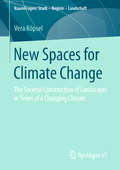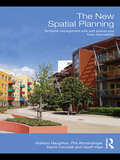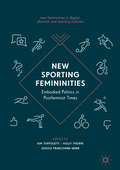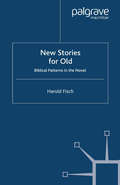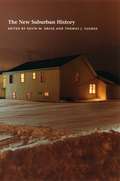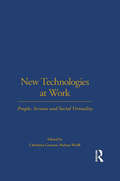- Table View
- List View
New Space For Women
by Gerda R WekerleIn recent years, increasing self-awareness has led women to examine and question their environments-largely designed and structured by men-in light of their particular needs and experiences. Inevitably, these changes in consciousness have led to demands for changes in existing architectural, social, and psychological environments and for an increas
New Space For Women
by Gerda R WekerleIn recent years, increasing self-awareness has led women to examine and question their environments-largely designed and structured by men-in light of their particular needs and experiences. Inevitably, these changes in consciousness have led to demands for changes in existing architectural, social, and psychological environments and for an increas
New Space Markets: Symposium Proceedings International Symposium 26–28 May 1997, Strasbourg, France (Space Studies #2)
by G. Haskell and M. RycroftSpace is no longer the special, protected domain that it was in the past. Because of the importance of its practical applications, it is becoming integrated into the mainstream of economic activity. Technology push is giving way to the assessment of market opportunities and demand pull. Funding from the public sector is declining while interest in private financing is steadily growing. The value-added and service industries are increasing in importance. New technologies will be developed in a context of privatisation, de-regulation and globalization. An international and interdisciplinary Symposium was organized by the International Space University to bring together a diverse group of people, technical and non-technical, engaged in the creation of new approaches to space applications, in order to share experiences and to exchange ideas on the way forward. The Proceedings of this Symposium make stimulating reading for all who are engaged in the market-place of space and its applications.
New Spaces for Climate Change: The Societal Construction of Landscapes in Times of a Changing Climate (RaumFragen: Stadt – Region – Landschaft)
by Vera KöpselVera Köpsel investigates the relevance of local perceptions of landscape and nature for the current topic of adaptation to climate change. She highlights the influence that differing conceptualisations of landscape among actors in environmental management have on their perspectives on climate change and adaptation. Qualitative empirical data from Cornwall (UK) constitutes a valuable foundation for an enhanced theoretical understanding of societal constructions of landscape and their implications for local negotiation processes. Using the example of coastal erosion, the author discusses how contrasting perceptions of a local landscape can significantly complicate consensus‐finding around physical‐material adaptation measures.
New Spaces of Exploration: Geographies of Discovery in the Twentieth Century (Tauris Historical Geographical Series)
by Simon Naylor James R. RyanOn the 2 March 1899 the British flag was hoisted on the Antarctic continent. The event - recorded in the first ever photograph taken on Antarctica - claimed possession on behalf of the British crown. A century later, 14,000 feet beneath the North Pole, a mini-submarine attached to a nuclear-powered ice breaker affixed the Russian flag to the Arctic seabed, and 213 miles above the Earth a Chinese astronaut waved the flag of the People's Republic.For many the dawn of the twentieth century ushered in what Joseph Conrad called 'Geography Triumphant', an era where the world map had few if any blank spaces left to discover and the figure of the lone explorer motivated by a noble quest for knowledge and adventure was banished for ever. The age of exploration was supposedly dead. New Spaces of Exploration challenges this assumption. Focussing specifically on exploration in the twentieth century the authors demonstrate how new technologies and changing geopolitical configurations have ensured that exploration has remained a key feature of our rapidly globalizing world.New Spaces of Exploration brings together scholars from a wide range of backgrounds - including historical, political, and cultural geography, history of science, cultural studies, art and cartography - to explore the spaces and politics of exploration over the past hundred years. Ranging widely in their geographical focus - from Europe and Asia to Australia, and from the polar regions to outer space - they demonstrate the increasing diversity of modern exploration and reveal the continuing political, military, industrial and cultural motivations at play. The result is a major contribution to our understanding of the significance of exploration in the twentieth century. Contributors: E. Baigent, C. Collis, K. Dodds, F. Driver, M. Godwin, J. Hill, F. Korsmo, F. MacDonald, S. Naylor, J. Ryan, N. Thomas, K. Yusoff.
The New Spatial Planning: Territorial Management with Soft Spaces and Fuzzy Boundaries
by Graham Haughton Philip Allmendinger David Counsell Geoff VigarSpatial planning, strongly advocated by government and the profession, is intended to be more holistic, more strategic, more inclusive, more integrative and more attuned to sustainable development than previous approaches. In what the authors refer to as the New Spatial Planning, there is a fairly rapidly evolving maturity and sophistication in how strategies are developed and produced. Crucially, the authors argue that the reworked boundaries of spatial planning means that to understand it we need to look as much outside the formal system of practices of ‘planning’ as within it. Using a rich empirical resource base, this book takes a critical look at recent practices to see whether the new spatial planning is having the kinds of impacts its advocates would wish. Contributing to theoretical debates in planning, state restructuring and governance, it also outlines and critiques the contemporary practice of spatial planning. This book will have a place on the shelves of researchers and students interested in urban/regional studies, politics and planning studies.
The New Spatial Planning: Territorial Management with Soft Spaces and Fuzzy Boundaries
by Graham Haughton Philip Allmendinger David Counsell Geoff VigarSpatial planning, strongly advocated by government and the profession, is intended to be more holistic, more strategic, more inclusive, more integrative and more attuned to sustainable development than previous approaches. In what the authors refer to as the New Spatial Planning, there is a fairly rapidly evolving maturity and sophistication in how strategies are developed and produced. Crucially, the authors argue that the reworked boundaries of spatial planning means that to understand it we need to look as much outside the formal system of practices of ‘planning’ as within it. Using a rich empirical resource base, this book takes a critical look at recent practices to see whether the new spatial planning is having the kinds of impacts its advocates would wish. Contributing to theoretical debates in planning, state restructuring and governance, it also outlines and critiques the contemporary practice of spatial planning. This book will have a place on the shelves of researchers and students interested in urban/regional studies, politics and planning studies.
New Sporting Femininities: Embodied Politics in Postfeminist Times (New Femininities in Digital, Physical and Sporting Cultures)
by Holly Thorpe Kim Toffoletti Jessica Francombe-WebbThis edited collection critically explores new and emerging models of female athleticism in an era characterised as postfeminist. It approaches postfeminism through a critical lens to investigate new forms of politics being practised by women in physical activity, sport and online spaces at the intersections of gender, ethnicity, sexuality and ability. New Sporting Femininities features chapters on celebrity athletes such as Serena Williams and Ronda Rousey, alongside studies of the online fitspo movement and women’s growing participation in activities like roller derby, skateboarding and football. In doing so, it highlights key issues and concerns facing diverse groups of women in a rapidly changing gender-sport landscape. This collection sheds new light on the complex and often contradictory ways that women’s athletic participation is promoted, experienced and embodied in the context of postfeminism, commodity feminism and emerging forms of popular feminism.
New Sporting Femininities: Embodied Politics in Postfeminist Times (New Femininities in Digital, Physical and Sporting Cultures)
by Holly Thorpe Kim Toffoletti Jessica Francombe-WebbThis edited collection critically explores new and emerging models of female athleticism in an era characterised as postfeminist. It approaches postfeminism through a critical lens to investigate new forms of politics being practised by women in physical activity, sport and online spaces at the intersections of gender, ethnicity, sexuality and ability. New Sporting Femininities features chapters on celebrity athletes such as Serena Williams and Ronda Rousey, alongside studies of the online fitspo movement and women’s growing participation in activities like roller derby, skateboarding and football. In doing so, it highlights key issues and concerns facing diverse groups of women in a rapidly changing gender-sport landscape. This collection sheds new light on the complex and often contradictory ways that women’s athletic participation is promoted, experienced and embodied in the context of postfeminism, commodity feminism and emerging forms of popular feminism.
The New States of Abortion Politics
by Joshua C. WilsonThe 2014 Supreme Court ruling on McCullen v. Coakley striking down a Massachusetts law regulating anti-abortion activism marked the reengagement of the Supreme Court in abortion politics. A throwback to the days of clinic-front protests, the decision seemed a means to reinvigorate the old street politics of abortion. The Court's ruling also highlights the success of a decades' long effort by anti-abortion activists to transform the very politics of abortion. The New States of Abortion Politics, written by leading scholar Joshua C. Wilson, tells the story of this movement, from streets to legislative halls to courtrooms. With the end of clinic-front activism, lawyers and politicians took on the fight. Anti-abortion activists moved away from a doomed frontal assault on Roe v. Wade and adopted an incremental strategy—putting anti-abortion causes on the offensive in friendly state forums and placing reproductive rights advocates on the defense in the courts. The Supreme Court ruling on Whole Woman's Health v. Hellerstedt in 2016 makes the stakes for abortion politics higher than ever. This book elucidates how—and why.
The New Store Workbook: The Essential Steps from Business Plan to Opening Day (Museum Store Association)
by Museum Store AssociationThe New Store Workbook gets down to the nitty gritty of planning to open a new museum store, from calculating the sales dollars needed per square foot, to estimating dollars spent by visitors, all the way to moving the whole operation onto the right e-commerce platform. The thirteen chapters that make up this journey are peppered with charts, tables, and real-world examples, including inventory projections, purchase orders, job announcements, and press releases. The new edition expands the discussion on social media, mobile shopping and new platforms for e-commerce and includes a complete chapter dedicated to the ins and outs of the Unrelated Business Income Tax. It’s your personal assistant, helping you embark on a successful adventure straight through opening day.
The New Store Workbook: The Essential Steps from Business Plan to Opening Day (Museum Store Association #2)
by Museum Store AssociationThe New Store Workbook gets down to the nitty gritty of planning to open a new museum store, from calculating the sales dollars needed per square foot, to estimating dollars spent by visitors, all the way to moving the whole operation onto the right e-commerce platform. The thirteen chapters that make up this journey are peppered with charts, tables, and real-world examples, including inventory projections, purchase orders, job announcements, and press releases. The new edition expands the discussion on social media, mobile shopping and new platforms for e-commerce and includes a complete chapter dedicated to the ins and outs of the Unrelated Business Income Tax. It’s your personal assistant, helping you embark on a successful adventure straight through opening day.
New Stories for Old: Biblical Patterns in the Novel (Cross Currents in Religion and Culture)
by H. FischHarold Fisch explores the biblical influence on the style and structure of landmark works by Fielding, Defoe, George Eliot, Kafka, Dostoevsky and others. Whilst the great novelists could not manage without the Bible, at the same time 'it would not do'. The book concludes with two chapters on the Israeli novelists S.Y. Agnon and A.B. Yehoshua.
The New Structural Social Work: Ideology, Theory, And Practice
by Bob Mullaly Marilyn DupreThe New Structural Social Work presents a coherent and consistent theory of progressive social work. With oppression as its central focus, the text demonstrates the shortcoming of welfare capitalism as a social system and how conventional social work fails to respond to systemic social problems. Emphasizing a progressive social work ethic, this text explores how students can incorporate a radical alternative to conventional social work within their own practice. Authors Bob Mullaly and Marilyn Dupré have fully updated this much-anticipated new edition.
A New Struggle for Independence in Modern Latin America
by Pablo A. BaisottiThis volume explores several notable themes related to foreign affairs in Latin America and the reconfiguration of the power of the different states in the region. It offers insightful historical perspectives for understanding national, regional and global issues from the beginning of the 20th century to the present day, from analysis of the traditional "hegemony" of the United States over Latin America through its military, and political influence due to the presence of the European Union, Russia, and China. These views cannot be reduced to a simplistic vision of the dominant and subordinate; rather, they attempt to seek lines of continuity by highlighting traditional interpretations of new scenarios such as regional trading and security blocs. The volume refuses to impose a traditional and uncritical linear historical narrative onto the reader and instead proposes an alternative interpretation of the past and its relation to the present. Finally, the growing importance of international mechanisms in enabling the success of certain Latin American regimes is also highlighted, in particular the influence of regional diffusion through international organizations or other networks.
A New Struggle for Independence in Modern Latin America
by Pablo A. BaisottiThis volume explores several notable themes related to foreign affairs in Latin America and the reconfiguration of the power of the different states in the region. It offers insightful historical perspectives for understanding national, regional and global issues from the beginning of the 20th century to the present day, from analysis of the traditional "hegemony" of the United States over Latin America through its military, and political influence due to the presence of the European Union, Russia, and China. These views cannot be reduced to a simplistic vision of the dominant and subordinate; rather, they attempt to seek lines of continuity by highlighting traditional interpretations of new scenarios such as regional trading and security blocs. The volume refuses to impose a traditional and uncritical linear historical narrative onto the reader and instead proposes an alternative interpretation of the past and its relation to the present. Finally, the growing importance of international mechanisms in enabling the success of certain Latin American regimes is also highlighted, in particular the influence of regional diffusion through international organizations or other networks.
The New Suburban History (Historical Studies of Urban America)
by Kevin M. Kruse Thomas J. SugrueAmerica has become a nation of suburbs. Confronting the popular image of suburbia as simply a refuge for affluent whites, The New Suburban History rejects the stereotypes of a conformist and conflict-free suburbia. The seemingly calm streets of suburbia were, in fact, battlegrounds over race, class, and politics. With this collection, Kevin Kruse and Thomas Sugrue argue that suburbia must be understood as a central factor in the modern American experience. Kruse and Sugrue here collect ten essays—augmented by their provocative introduction—that challenge our understanding of suburbia. Drawing from original research on suburbs across the country, the contributors recast important political and social issues in the context of suburbanization. Their essays reveal the role suburbs have played in the transformation of American liberalism and conservatism; the contentious politics of race, class, and ethnicity; and debates about the environment, land use, and taxation. The contributors move the history of African Americans, Latinos, Asians, and blue-collar workers from the margins to the mainstream of suburban history. From this broad perspective, these innovative historians explore the way suburbs affect—and are affected by—central cities, competing suburbs, and entire regions. The results, they show, are far-reaching: the emergence of a suburban America has reshaped national politics, fostered new social movements, and remade the American landscape. The New Suburban History offers nothing less than a new American history—one that claims the nation cannot be fully understood without a history of American suburbs at its very center.
The New Suburbia: How Diversity Remade Suburban Life in Los Angeles after 1945
by Becky M. NicolaidesAmerica's suburbs have been transforming. The conventional story of suburbs as bastions of white, middle-class homeowners no longer describes the suburbs of America's cities. Today they house a more typical cross-section of the nation--rich, poor, Black American, Latino, Asian, immigrant, the unhoused, the lavishly housed, and everyone in between. Stories of everyday suburban life, in the process, have taken on new inflections. Nowhere are these changes more vivid than in Los Angeles. In this suburban metropolis and global powerhouse, lily white suburbs have virtually disappeared, and over two-thirds of the County's suburbs have become majority minority. Examining this vanguard of change from the postwar to the present, The New Suburbia follows the Asian Americans, Black Americans, and Latinos who moved into white neighborhoods that once barred them. They bought homes, enrolled their children in schools, and began navigating suburban life. They faced a choice: would they remake the suburbs, or would the suburbs remake them? In places like Pasadena, San Marino, South Gate, and Lakewood, suburbanites faced the challenges of living together in difference. Historian Becky Nicolaides explores a range of community experiences, from internal resegregation to suburban poverty, an embrace of law-and-order culture to police brutality, friendly neighbors to social withdrawal. In some communities, diverse residents continued longstanding habits of exclusion and perpetuated metropolitan inequality. In others, they embraced more inclusive, multicultural suburban ideals. Through it all, the common denominators of suburbia remained--low-slung landscapes of single-family homes and families seeking the good life. An authoritative work based on a half-century of quantitative data and unpublished oral histories and interviews, The New Suburbia explores vital landscapes where the American dream has endured, even as the dreamers have changed.
The New Suburbia: How Diversity Remade Suburban Life in Los Angeles after 1945
by Becky M. NicolaidesAmerica's suburbs have been transforming. The conventional story of suburbs as bastions of white, middle-class homeowners no longer describes the suburbs of America's cities. Today they house a more typical cross-section of the nation--rich, poor, Black American, Latino, Asian, immigrant, the unhoused, the lavishly housed, and everyone in between. Stories of everyday suburban life, in the process, have taken on new inflections. Nowhere are these changes more vivid than in Los Angeles. In this suburban metropolis and global powerhouse, lily white suburbs have virtually disappeared, and over two-thirds of the County's suburbs have become majority minority. Examining this vanguard of change from the postwar to the present, The New Suburbia follows the Asian Americans, Black Americans, and Latinos who moved into white neighborhoods that once barred them. They bought homes, enrolled their children in schools, and began navigating suburban life. They faced a choice: would they remake the suburbs, or would the suburbs remake them? In places like Pasadena, San Marino, South Gate, and Lakewood, suburbanites faced the challenges of living together in difference. Historian Becky Nicolaides explores a range of community experiences, from internal resegregation to suburban poverty, an embrace of law-and-order culture to police brutality, friendly neighbors to social withdrawal. In some communities, diverse residents continued longstanding habits of exclusion and perpetuated metropolitan inequality. In others, they embraced more inclusive, multicultural suburban ideals. Through it all, the common denominators of suburbia remained--low-slung landscapes of single-family homes and families seeking the good life. An authoritative work based on a half-century of quantitative data and unpublished oral histories and interviews, The New Suburbia explores vital landscapes where the American dream has endured, even as the dreamers have changed.
New Takes in Film-Philosophy
by Havi Carel and Greg TuckThis collection displays a range of approaches and contemporary developments in the expanding field of film-philosophy. The essays explore central issues surrounding the conjunction of film and philosophy, presenting a varied yet coherent reflection on the nature of this conjunction.
New Technologies and Emerging Spaces of Care
by Miquel DomènechNew Technologies and Emerging Spaces of Care provides the latest practice-oriented qualitative research and innovative conceptual discussions of how health and health care systems are currently dealing with complex transformations and varied reforms. Exploring and analysing the social and cultural impact of new technologies, this book examines the societal relevance of new technologies of care and the manner in which technological innovations configure and reconfigure institutionalized spaces of care. It addresses issues of social control, accountability, surveillance and disciplining; diverging patterns of inclusion and exclusion; new relations and subjectivities of patients and care givers; the relation between private and public forms of care and the practices and concerns generated by new technologies at the individual as well as the societal level. Presenting sophisticated theoretical discussions and detailed empirical case studies, New Technologies and Emerging Spaces of Care analyses, compares and evaluates on a transnational level the role and impact of (assistive) technologies for elderly and disabled people on the concepts and practices of spaces of care. A critical understanding of contemporary practices of care, that cuts through the growing conceptual barriers between social and medical models of care studies, this book will be of interest to those interested in new technologies, health care and social space of care. Specifically, it will appeal to scholars of science and technology studies, medical sociology and the sociology of the body, social inequality and exclusion, health and care studies, gerontology and disability studies.
New Technologies and Emerging Spaces of Care
by Miquel DomènechNew Technologies and Emerging Spaces of Care provides the latest practice-oriented qualitative research and innovative conceptual discussions of how health and health care systems are currently dealing with complex transformations and varied reforms. Exploring and analysing the social and cultural impact of new technologies, this book examines the societal relevance of new technologies of care and the manner in which technological innovations configure and reconfigure institutionalized spaces of care. It addresses issues of social control, accountability, surveillance and disciplining; diverging patterns of inclusion and exclusion; new relations and subjectivities of patients and care givers; the relation between private and public forms of care and the practices and concerns generated by new technologies at the individual as well as the societal level. Presenting sophisticated theoretical discussions and detailed empirical case studies, New Technologies and Emerging Spaces of Care analyses, compares and evaluates on a transnational level the role and impact of (assistive) technologies for elderly and disabled people on the concepts and practices of spaces of care. A critical understanding of contemporary practices of care, that cuts through the growing conceptual barriers between social and medical models of care studies, this book will be of interest to those interested in new technologies, health care and social space of care. Specifically, it will appeal to scholars of science and technology studies, medical sociology and the sociology of the body, social inequality and exclusion, health and care studies, gerontology and disability studies.
New Technologies and the Media (Key Concerns in Media Studies)
by Gerard GogginThe landscape of the media is changing - and at an ever-increasing pace. New technologies are fast transforming the way we consume information, and the way we live our lives. New Technologies and the Media by Proffessor Gerard Goggin (University of Sydney) is an authoritative exploration of the impact of the internet, the iPad, and Wikileaks on contemporary news, journalism and broadcasting. Steering clear of technological jargon, this is a short, sharp, simple guide through this complex subject. This book is essential reading for all media students and researchers - and for anyone interested in getting to grips with the ways in which media is becoming a progressively more pervasive, intimate and powerful part of life in the 2010s. It engagingly examines the the issues raised by the presence of new technologies across news, television, internet and mobiles. Under discusson are: new audiences forming around user-generated content; the future of news and journalism; the rapid shape-shifting of broadcasting in the face of the internet; an explosion of devices; the viewer as "couch-commander"; blogging, social media and citizen journalism and public-service media; the cultural politics of digital cultures and technologies. Featuring fascinating case studies of modern phenomena such as the iPhone, this book examines current cutting-edge technologies by situating them within the broader context of communications and media history. Written by an expert in the field, it cuts through the controversial and confusing debate surrounding the use of new technologies in the media and gives a clear, considered account of the major issues involved. By accessibly introducing the key theories of technology, this book will equip its readers with a solid critical approach that they can use across their studies, invesitigations and work in media. It provides the tools needed by students and researchers to accurately analyse and effectively evaluate how new technologies shape, and are shaped by, media. New Technology and the Media offers an excellent insight into an important, exciting, expanding area of interest.
New Technologies at Work: People, Screens and Social Virtuality
by Christina GarstenInformation and communication technologies have completely revolutionized our working practices. Career patterns, professional identities, speed of communication, time management, and mobility have been irrevocably changed in an amazingly short period. Drawing on worldwide case studies, this fascinating book explores these transformations and looks to what developments are in store for us in the future. Flexible hours, email, virtual meetings rooms, and working from home are all relatively new additions to our professional lives. The effects of these technological advances have been dramatic and far-reaching. Not only have they helped to connect organizations and institutions in developing countries to the rest of the world, but they also allow people to maintain extensive geographical networks with friends, families, and colleagues. The use of virtual reality and multimedia has had a huge impact on careers ranging from investment banking to molecular biology, and has brought fundamental changes to education and training, the generation of new ideas, and problem solving. This book investigates both the impact of information technology on working practices and, more complexly, how I.T. is bound up in social, political, and economic issues. How are power relations established and maintained through transnational networking? Can the Internet be used as a political tool to manipulate the masses? In what ways has digital technology changed the aesthetics and practices of the Euro-American dance world? What initiatives have been undertaken to ensure people arent excluded from the digital world and have they succeeded? Through answering these and many more questions, this groundbreaking book is an essential guide to the modern day world.
New Technologies at Work: People, Screens and Social Virtuality
Information and communication technologies have completely revolutionized our working practices. Career patterns, professional identities, speed of communication, time management, and mobility have been irrevocably changed in an amazingly short period. Drawing on worldwide case studies, this fascinating book explores these transformations and looks to what developments are in store for us in the future. Flexible hours, email, virtual meetings rooms, and working from home are all relatively new additions to our professional lives. The effects of these technological advances have been dramatic and far-reaching. Not only have they helped to connect organizations and institutions in developing countries to the rest of the world, but they also allow people to maintain extensive geographical networks with friends, families, and colleagues. The use of virtual reality and multimedia has had a huge impact on careers ranging from investment banking to molecular biology, and has brought fundamental changes to education and training, the generation of new ideas, and problem solving. This book investigates both the impact of information technology on working practices and, more complexly, how I.T. is bound up in social, political, and economic issues. How are power relations established and maintained through transnational networking? Can the Internet be used as a political tool to manipulate the masses? In what ways has digital technology changed the aesthetics and practices of the Euro-American dance world? What initiatives have been undertaken to ensure people arent excluded from the digital world and have they succeeded? Through answering these and many more questions, this groundbreaking book is an essential guide to the modern day world.


